|
at the Matsunaga Jian Memorial Museum
September 14, 15, and 16, 2002
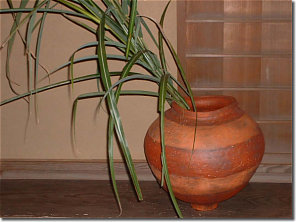
Large jar (tsubo) by Uchida Koichi
Matsunaga Yasuzaemon (1875-1971) was one of the great industrialists and art collectors of the 20th century. He made his fortune in power companies and retired from that world at the age of sixty and took the Tea name Jian (part of a saying from the Analects of Confucius, basically meaning "follow your ear after sixty"). In 1946 he built a Tea house called Roukyosou (Old Zelkova House) in Odawara, Kanagawa Prefecture, to display his immense collection. Of course, not all at once, but depending on the season and guests. Roukyosou is an elegant building with a quiet elegance amidst a natural setting that instantly soothes the senses. It's a perfect place to enjoy art.

Industrialist Matsunaga Yasuzaemon
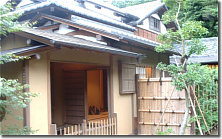 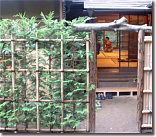
Side view of house (L) and Entrance (R)
 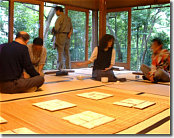
Lady enjoying art in tokonoma (L) and Visitors sitting on floor (R)
Matsunaga's collection has been displayed at the Tokyo National Musuem. Roukyosou was purchased by the City of Odawara and is now part of the Matsunaga Jian Memorial Museum. Recently it was opened up to display the works of the young and very talented ceramic artist Uchida Koichi (1969 - ).
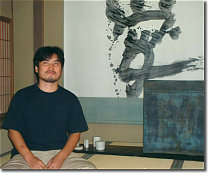
Artist Uchida Koichi
Briefly, Uchida was born in Nagoya and studied at the Seto Ceramic High School, graduating in 1990. In 1992 he set up his kiln in Yokkaichi, Mie Prefecture, and has been busy ever since. He's had exhibitions throughout Japan and his work has been featured on the covers of quite a few magazines, including
Tojiro.
Why? Simply, his sense and skill are beyond his years. As they say here in Japan, he's "uma-sugiru" (too skilled). But his work is not only about skill and technique; it's also about his keen sense and understanding of antique wares not only from Japan but also from Korea, China, Thailand, and other Asian countries.
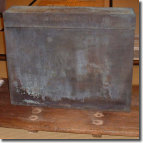 As I entered the tranquil building, a large ancient bronze-like box greeted me (photo at right). It was actually made of clay and Uchida fired it after coating it with copper to bring out the iridescent luster. It was quite a deceiving work as were a similar box in the tokonoma (alcove) and a rounded box. As I entered the tranquil building, a large ancient bronze-like box greeted me (photo at right). It was actually made of clay and Uchida fired it after coating it with copper to bring out the iridescent luster. It was quite a deceiving work as were a similar box in the tokonoma (alcove) and a rounded box.
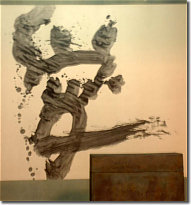 Also in the tokonoma was an outstanding powerful hanging scroll (photo at left) by Inoue Ryoji, which had the kanji for ai or love. Alongside the box was a set of hakuji (white porcelain) small boxes. Also in the tokonoma was an outstanding powerful hanging scroll (photo at left) by Inoue Ryoji, which had the kanji for ai or love. Alongside the box was a set of hakuji (white porcelain) small boxes.
Uchida excels in hakuji and there were many examples of it throughout the maze-like house. I saw some fluted cups, almost reminiscent of Delft wares, hexagonal dishes in a Korean Yi dynasty vein, small kyusu (tea pots), soba cups, spoons, and some wonderful chawan (tea bowls) with kodai (feet) that were creamy and soft, almost looking like some vanilla ice-cream. See below for photos of various pieces.
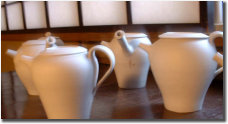
Small kyusu (tea pots)
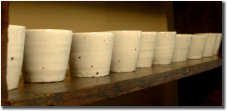
Soba cups

Vanilla-like foot of chawan
There were also some very standard looking white plates one might see at a corner diner. Yet, upon picking them up and feeling the smooth glaze, the weight, and how they had ever-so-slight imperfections, I was quite taken aback with Uchida's subtle hand. A Zen monk from a local temple ended up taking a few home (see photo below).
Other works were in gold and silver overglazes, a painted tsubo (large jar; see photo at top of page), and some were of mixed clay "puzzle" plates and small desk-shaped food stands much like some of Kakurezaki Ryuichi's work.
 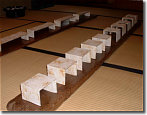 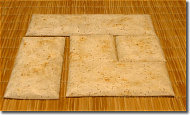
L to R - White plates, desk-shaped food stands, and puzzle plates
As a matter of fact, some years ago when I asked Kakurezaki who he thought was good these days he replied Uchida. This was the first time I had actually seen Uchida'a work and now I know the reason behind Kakurezaki's reply. Of course it was only a sampling of his output and I am greatly looking forward to seeing more. He made it all look so easy.
.
|